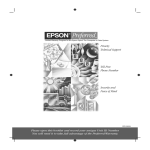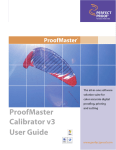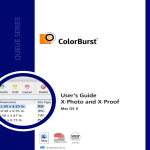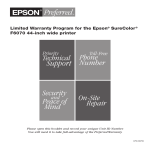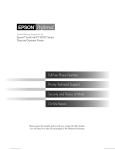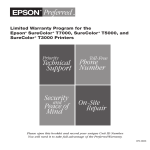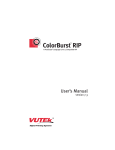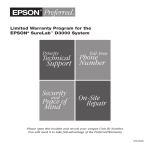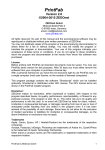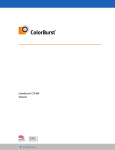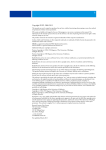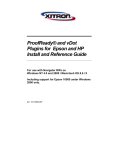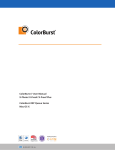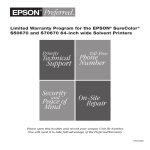Download Stylus Pro 4000 Series - User Manual - ColorBurst Rip
Transcript
ColorBurst.book Page 1 Thursday, September 9, 2004 12:41 PM for the Epson Stylus Pro 4000 ® User’s Guide ColorBurst.book Page 2 Thursday, September 9, 2004 12:41 PM All rights reserved. No part of this publication may be reproduced, stored in a retrieval system, or transmitted in any form or by any means, electronic, mechanical, photocopying, recording, or otherwise, without the prior written permission of Seiko Epson Corporation. The information contained herein is designed only for use with this Epson product. Epson is not responsible for any use of this information as applied to other products. Trademarks Epson, Epson Stylus, and MicroWeave are registered trademarks of Seiko Epson Corporation. Epson Preferred is a service mark of Epson America, Inc. ColorBurst is a registered trademark of CSE Systems, Inc. General Notice: Other product names used herein are for identification purposes only and may be trademarks of their respective owners. Epson disclaims any and all rights in those marks. Legal Notices Neither Seiko Epson Corporation nor its affiliates shall be liable to the purchaser of this product or third parties for damages, losses, costs, or expenses incurred by purchaser or third parties as a result of: accident, misuse, or abuse of this product or unauthorized modifications, repairs, or alterations to this product, or (excluding the U.S.) failure to strictly comply with Seiko Epson Corporation’s operating and maintenance instructions. Printed on recycled paper. © 2004 Epson America, Inc. 9/04 CPD-18563 ColorBurst.book Page 3 Thursday, September 9, 2004 12:41 PM | 3 Contents Introduction Choosing a RIP Configuration . . . . . . . . . . . . . . . . . . . . . . . . . . . . . . . . 5 ColorBurst RIP Features . . . . . . . . . . . . . . . . . . . . . . . . . . . . . . . . . . . . . 5 Installing and Setting Up the Server Software Installing the ColorBurst Server Software for Macintosh OS X . . . . . . . . 7 Setting Up the ColorBurst RIP Server for Macintosh OS X . . . . . . . . . . 8 Installing the ColorBurst RIP Server Software for Windows . . . . . . . . . 15 Setting Up the ColorBurst RIP Server for Windows . . . . . . . . . . . . . . . 17 Setting Up Client Systems Setting Up Macintosh OS X Clients to Print to a Mac OS X RIP Server . . . . . . . . . . . . . . . . . . . . . . . . . . . . . . . . . . . . . . . . . . . 21 Setting Up Windows Clients to Print to a Mac OS X RIP Server . . . . . 24 Setting Up Windows Clients to Print to a Windows RIP Server . . . . . . 30 Printing Printing From an Application . . . . . . . . . . . . . . . . . . . . . . . . . . . . . . . . 33 Printing Using a Hot Folder . . . . . . . . . . . . . . . . . . . . . . . . . . . . . . . . . 34 Drag-and-Drop Printing on the RIP Server (Mac OS X) . . . . . . . . . . . 38 Supported File Types . . . . . . . . . . . . . . . . . . . . . . . . . . . . . . . . . . . . . . 38 Managing Print Jobs on the Mac OS X RIP Server Holding, Activating, Canceling, and Deleting Jobs . . . . . . . . . . . . . . . . 39 Changing File Attributes . . . . . . . . . . . . . . . . . . . . . . . . . . . . . . . . . . . . 40 Reordering Print Jobs . . . . . . . . . . . . . . . . . . . . . . . . . . . . . . . . . . . . . . 41 Reprinting Files In the Done List . . . . . . . . . . . . . . . . . . . . . . . . . . . . . 42 Color Management and Printer Linearization Using Color Management Settings in Mac OS X . . . . . . . . . . . . . . . . . 43 Using Color Management Settings in Windows . . . . . . . . . . . . . . . . . . 47 Relinearizing an Existing Printer Setup . . . . . . . . . . . . . . . . . . . . . . . . . 51 3 ColorBurst.book Page 4 Thursday, September 9, 2004 12:41 PM 4 | Contents Appendix Where To Get Help . . . . . . . . . . . . . . . . . . . . . . . . . . . . . . . . . . . . . . . 59 System Requirements . . . . . . . . . . . . . . . . . . . . . . . . . . . . . . . . . . . . . . 59 Index -4 ColorBurst.book Page 5 Thursday, September 9, 2004 12:41 PM | 5 Introduction Note: If you are using Windows,® you must be running Windows XP or 2000; other versions of Windows are not supported. This User’s Guide provides instructions for installing and setting up the ColorBurst® RIP (Raster Image Processor) software on your server and client workstations. The software prepares your network for printing on the Epson Stylus® Pro 4000 printer. This guide also explains environment setup and printer linearization, printing from applications, and using hot folders for drag-and-drop printing of supported files. Your ColorBurst software CD-ROM includes the ColorBurst server software and client PPD (PostScript® Printer Description) software, as well as the ChromaCapture CSE (Macintosh®) or ColorBurst ColorCatch (Windows) utility for printer linearization. Before setting up the ColorBurst RIP, you should make sure you’ve set up the Stylus Pro 4000 on the computer that will control the printer. Even if you plan to connect the printer directly to the network, you should install and configure it locally first. See your Stylus Pro 4000 Start Here sheet for instructions. Tip: The recommended configuration is to connect the Stylus Pro 4000 via USB to a Mac OS® X system set up as the dedicated server with the ColorBurst RIP. Then connect the Mac OS X system to the network. Mac® or Windows clients may print to the RIP server. This configuration minimizes network traffic. Note: The Client PPD does not need to be installed on the ColorBurst RIP server. Choosing a RIP Configuration There are a number of options available for setting up the ColorBurst RIP and your Stylus Pro 4000: • Connect the printer via USB or Ethernet to a Macintosh OS X or Windows computer with ColorBurst installed. That system acts as the RIP server on the network. You can print from that computer or send print jobs from other computers on your network. If you have both Mac OS X and Windows client systems, you must install the ColorBurst RIP server software on a Macintosh. • Connect the printer via USB or Ethernet to a single computer set up as the ColorBurst RIP server and client. ColorBurst RIP Features • Pantone® and SWOP® certified for highly accurate color printing • Full PostScript support including PostScript Language level 1, 2, and 3 support for PS, EPS, TIFF, JPEG, and PDF files • Hot folder that can be accessed locally or over a network for easy printing of supported file types 5 ColorBurst.book Page 6 Thursday, September 9, 2004 12:41 PM 6 | Introduction • Job manager (Mac OS X only) for drag-and-drop printing directly into the RIP list. Jobs can be reordered, deleted, or placed on hold to be processed later • Pre-linearized environments to ensure accurate profiles from the start, as well as the option to relinearize later with a spectrophotometer, if necessary 6 ColorBurst.book Page 7 Thursday, September 9, 2004 12:41 PM | 7 Installing and Setting Up the Server Software You can install and set up the ColorBurst RIP server software on a Macintosh OS X system or a computer running Windows XP or 2000. See the appropriate sections: • “Installing the ColorBurst Server Software for Macintosh OS X” below • “Setting Up the ColorBurst RIP Server for Macintosh OS X” on page 8 • “Installing the ColorBurst RIP Server Software for Windows” on page 15 • “Setting Up the ColorBurst RIP Server for Windows” on page 17 Installing the ColorBurst Server Software for Macintosh OS X Before you begin, make sure you have: • Set up the Epson Stylus Pro 4000 and installed the standard Epson printer driver on the computer you intend to use as your ColorBurst RIP server (see your Epson® printer documentation for instructions) • Connected the printer to the server using the USB interface (recommended method) or connected the printer to an Ethernet network and assigned it an IP address (see the documentation that came with the included network card) • Closed all open programs and turned off any virus protection programs Follow these steps to install the server software: 1. Insert the ColorBurst RIP CD-ROM in your CD-ROM or DVD drive. 2. Double-click the CD-ROM icon, then double-click the ColorBurst RIP Installer icon. 7 ColorBurst.book Page 8 Thursday, September 9, 2004 12:41 PM 8 | Installing and Setting Up the Server Software 3. When prompted, enter your Mac OS X Admin password and click OK. 4. Follow the on-screen instructions to install ColorBurst. 5. When installation is complete, go to the next section to set up the ColorBurst RIP Server. Setting Up the ColorBurst RIP Server for Macintosh OS X Note: If you plan to share the printer with Windows clients over a network, you need to make sure your Macintosh has a static (manual setting) IP address that won’t change. You can change this setting in the System Preferences > Network settings. See your Mac Help for more information. Before you can print with the ColorBurst RIP, you have to set it up so it can receive print jobs and has the correct printer and environment settings. Starting the RIP Server and Choosing Your Printer 1. To start the RIP server, double-click the ColorBurst RIP for Epson icon on your desktop. Or double-click the ColorBurst RIP icon in the Applications > ColorBurst RIP for Epson folder. 2. When you see the registration window, fill out the information and click OK to register your software. The serial number is printed on the front of your ColorBurst RIP CD-ROM. The registration is sent over the Internet to ColorBurst. If it isn’t sent, the dialog box will reappear each time you start the RIP. 8 ColorBurst.book Page 9 Thursday, September 9, 2004 12:41 PM Installing and Setting Up the Server Software | 9 3. When you see this message, click OK. 4. When you see this message, click OK. 5. Type a name for the printer in the Printer Name box. It can be any name you want. This name is used only within the RIP/server interface and is not the name that will be used on the network. (See “Setting the Print Server Name” on page 13 to change the RIP name used on the network.) 6. Choose USB or Ethernet as the Printer Connection setting. 7. Choose Stylus Pro 4000 from the Which Printer list that appears, if necessary. If you see the message “There are no printers connected to this computer using USB,” check your USB connection and make sure the printer is set up and turned on as described on your Stylus Pro 4000 Start Here sheet. 9 ColorBurst.book Page 10 Thursday, September 9, 2004 12:41 PM 10 | Installing and Setting Up the Server Software 8. When you see this message, click OK. 9. When you see this screen, enter your Mac OS X Admin password, then click OK. ColorBurst opens and is now set up with the default environment. To enable the RIP to receive and process print jobs and set up the proper environment for your needs, see the next section. Choosing an Environment and Printer Settings The ColorBurst workflow is designed to be efficient for graphic design as well as prepress proofing. Several pre-set environments with defined paper type and resolution settings are included for your Stylus Pro 4000 printer. Choose an environment for the paper type that is loaded in the printer and the resolution you prefer for printing. You need to change the environment each time you load a different type of paper. Also check the printer settings and adjust them, if necessary. Once the environment and settings are set up, clients can send print jobs without having to constantly adjust printer and driver settings. 10 ColorBurst.book Page 11 Thursday, September 9, 2004 12:41 PM Installing and Setting Up the Server Software | 11 1. To start the RIP server, double-click the ColorBurst RIP for Epson icon on your desktop. Or double-click the ColorBurst RIP icon in the Applications > ColorBurst RIP for Epson folder. You see the ColorBurst RIP server window: Environment list Printer Settings button 2. Choose the resolution and paper type you want to use from the Environment list. 11 ColorBurst.book Page 12 Thursday, September 9, 2004 12:41 PM 12 | Installing and Setting Up the Server Software 3. Click Printer Settings to open the Printer Settings window. 4. Make changes to these settings, as necessary: Note: The Use Page Settings options are only used for files with unknown page description information, such as when you drop a TIFF or JPEG file into a hot folder. • Choose 4-Pass for the Print Quality (when available). If you notice any type of banding, then try 8-Pass. If you still see banding in 8-Pass mode, perform a nozzle check on the Stylus Pro 4000 (see your Stylus Pro 4000 Printer Guide for details). • Choose Print from Roll or Print from Sheet, depending on the paper source you are using • Choose Use Bidirectional Printing to print in both directions (turn this off for best quality) • Choose Edge-To-Edge Printing to allow borderless printing • Choose Cut Media to allow the printer to use the printer’s cut method to cut roll paper • Click Advanced Media Control to adjust the setting for precise paper feeding • Click Use Page Settings to set paper width and height settings, to center the image on the page, or offset it by a specific distance 12 ColorBurst.book Page 13 Thursday, September 9, 2004 12:41 PM Installing and Setting Up the Server Software | 13 5. Click OK. You return to the ColorBurst RIP server window. Continue with the next section to set a Print Server Name. Setting the Print Server Name Note: For Windows clients, you also need to know the IP address of the computer that is running the ColorBurst RIP. The IP address should be static (manual setting) and can be found under the System Preferences > Network settings. Before you set up any client computers to print to the RIP, you should check the Print Server Name and change it, if desired. You need to know the Print Server Name to set up Windows clients to print to the ColorBurst RIP. 1. Choose Preferences from the ColorBurst RIP menu. You see this menu: Print Server Name 2. Write down the Print Server Name that appears in the box (the default is ColorBurst_RIP), or change it to something else to identify the printer over the network. 3. When you are done, click OK. 13 ColorBurst.book Page 14 Thursday, September 9, 2004 12:41 PM 14 | Installing and Setting Up the Server Software Enabling the RIP to Receive Print Jobs and Print By default, the ColorBurst RIP receives and holds print jobs until it is set to RIP On and the print jobs are activated. You can change this setting to automatically receive and print jobs as they are sent to the RIP. 1. To start the RIP server, double-click the ColorBurst RIP for Epson icon on your desktop. Or double-click the ColorBurst RIP icon in the Applications > ColorBurst RIP for Epson folder. You see the ColorBurst RIP server window: RIP On button Receive On Hold box 2. To enable the RIP to print active jobs, click the RIP On button. 3. To receive print jobs with active status and automatically print them in the order they are received, click the Receive On Hold checkbox to deselect it. If you keep it selected, all the print jobs that are sent to the RIP will be held until you activate them. 14 ColorBurst.book Page 15 Thursday, September 9, 2004 12:41 PM Installing and Setting Up the Server Software | 15 If you will be printing from other computers on the network, install the client PPDs and set up the clients for printing. See “Setting Up Client Systems” on page 21. For details on managing print jobs, see page 39. Installing the ColorBurst RIP Server Software for Windows Note: The Windows RIP server software supports printing from Windows XP and Windows 2000 client computers only. To print with both Macintosh and Windows clients, you must install the RIP server software on a Macintosh server. See page 7. Before you begin, make sure you have: • Set up the Epson Stylus Pro 4000 and installed the standard Epson printer driver on the computer you intend to use as your ColorBurst RIP server (see your Epson printer documentation for instructions) • Connected the printer to the server using the USB interface (recommended method) or connected the printer to an Ethernet network and assigned it an IP address (see the documentation that came with the included network card) and that you are able to print from the standard driver • Closed all open programs and turned off any virus protection programs Follow these steps to install the server software: 1. Insert the ColorBurst RIP CD-ROM into your drive. 2. Double-click the ColorBurst Epson Installer icon. 3. Follow the on-screen instructions to install the ColorBurst RIP. 4. When you see the message “Digital Signature Not Found,” click Yes to continue the installation. 5. Restart your computer. 6. Go to Start > Settings > Printers (or Start > Printers and Faxes). 7. Right-click the ColorBurst RIP printer icon and choose Properties. 15 ColorBurst.book Page 16 Thursday, September 9, 2004 12:41 PM 16 | Installing and Setting Up the Server Software 8. Click the Sharing tab. 9. Select Share this printer. Click OK. Go to the next section to start and set up the ColorBurst RIP server. 16 ColorBurst.book Page 17 Thursday, September 9, 2004 12:41 PM Installing and Setting Up the Server Software | 17 Setting Up the ColorBurst RIP Server for Windows 1. To start the RIP server, double-click the ColorBurst Epson icon on your desktop. 2. When you see the Registration screen, fill out the information and click OK to register your software. The serial number is printed on the front of the ColorBurst RIP CD-ROM. You see the ColorBurst RIP server window: 17 ColorBurst.book Page 18 Thursday, September 9, 2004 12:41 PM 18 | Installing and Setting Up the Server Software 3. From the Options menu, choose Printer Options, then click the General tab. 4. Under Print Queue, choose EPSON Stylus Pro 4000. Note: The Use page dimensions options are only used for files with unknown page description information, such as when you drop a TIFF or JPEG file into a hot folder. If you are printing from an application, your print settings will override these settings. 5. Click Use page dimensions to set paper width and height settings, to center the image on the page, or offset it by a specific distance. 6. Click the Epson 4000 tab. Make changes to these settings, as necessary: • Choose 4 Pass for the MicroWeave® setting. If you notice any type of banding, then try 8 Pass. If you still see banding in 8 Pass mode, perform a nozzle check (see your Stylus Pro 4000 Printer Guide for details). 18 ColorBurst.book Page 19 Thursday, September 9, 2004 12:41 PM Installing and Setting Up the Server Software | 19 • Choose Roll fed media or Sheet fed media, depending on the paper source you are using • Choose Borderless printing to allow edge-to-edge printing • Choose Bidirectional Printing to print in both directions (turn this off for best quality) • Choose Cut media to allow the printer to use the printer’s cut method to cut roll paper • Enter a value in the Micro media feed adjustment box if you need to adjust the setting for precise paper feeding 7. Click OK. 8. From the Environment menu, click Load. 9. Open the Color or Grayscale folder, then choose the environment file for your paper type and resolution. 10. Click Open, then click Yes. 11. Click Start Spooler to start the RIP. 19 ColorBurst.book Page 20 Thursday, September 9, 2004 12:41 PM 20 | Installing and Setting Up the Server Software 20 ColorBurst.book Page 21 Thursday, September 9, 2004 12:41 PM | 21 Setting Up Client Systems Note: To print with both Macintosh and Windows clients, you must install the RIP server software on a Macintosh server. See page 7. See the appropriate section to set up client systems for printing: • “Setting Up Macintosh OS X Clients to Print to a Mac OS X RIP Server” below • “Setting Up Windows Clients to Print to a Mac OS X RIP Server” on page 24 • “Setting Up Windows Clients to Print to a Windows RIP Server” on page 30 Setting Up Macintosh OS X Clients to Print to a Mac OS X RIP Server 1. Make sure your computer is connected to the same network as the ColorBurst RIP server computer. 2. Insert the ColorBurst RIP CD-ROM in the CD-ROM or DVD drive. Note: You can also find the PPD installer in the ColorBurst RIP for Epson > Utilities folder on the server. Copy the file to the system where you want to install it, then double-click the installer icon. 3. Double-click the CD-ROM icon, then double-click the ColorBurst Client Installer icon. 4. When you see this screen, enter your Mac OS X Admin password, then click OK. 5. Follow the on-screen instructions to install the ColorBurst client software. 6. When installation is complete, check the ColorBurst RIP server computer to make sure ColorBurst is running. 21 ColorBurst.book Page 22 Thursday, September 9, 2004 12:41 PM 22 | Setting Up Client Systems 7. Open the Mac OS X Print Center (OS X 10.2.x) or Printer Setup Utility (OS X 10.3.x) in the Applications > Utilities folder. 8. Click the Add button to add a printer. You may see this message if you have not installed any printers on your computer. Click Add. 9. On the next screen, select Rendezvous from the pop-up menu. 22 ColorBurst.book Page 23 Thursday, September 9, 2004 12:41 PM Setting Up Client Systems | 23 10. Select the ColorBurst RIP print server name that you specified (see “Setting the Print Server Name” on page 13) from the list of Rendezvous printers. 11. Select ColorBurst RIP Server from the Printer Model list. 12. Highlight ColorBurst - EPSON StylusPro4000. 13. Click Add to add the printer. You see the ColorBurst RIP Print Server name in the printer list. 14. Close Print Center or the Printer Setup Utility. You’re ready to print to the ColorBurst RIP. 23 ColorBurst.book Page 24 Thursday, September 9, 2004 12:41 PM 24 | Setting Up Client Systems Setting Up Windows Clients to Print to a Mac OS X RIP Server ColorBurst supports Windows 2000 and Windows XP. Other Windows operating systems are not supported. 1. Make sure your computer is connected to the same network as the ColorBurst RIP server computer. 2. Insert the ColorBurst RIP CD-ROM into the CD-ROM or DVD drive. 3. Windows 2000: Click Start > Settings > Printers. Windows XP: Click Start > Control Panel > Printers and Other Hardware > Printers and Faxes. Add Printer icon, then click Next. 4. Double-click the 5. The following screen appears. Make sure the Local printer attached to this computer button is selected and Automatically detect and install my Plug and Play printer is unchecked. Then click Next. 24 ColorBurst.book Page 25 Thursday, September 9, 2004 12:41 PM Setting Up Client Systems | 25 6. Click Create a new port, select Standard TCP/IP Port, and click Next. 7. When you see the Add Standard TCP/IP Print Port Wizard screen, click Next. 8. Enter the IP address for the Macintosh with the ColorBurst RIP server (located under System Preferences > Network settings), then click Next. 25 ColorBurst.book Page 26 Thursday, September 9, 2004 12:41 PM 26 | Setting Up Client Systems 9. Select Custom and click the Settings button. 10. You see this screen: Select the following settings: • Protocol: LPR • Queue Name: enter the ColorBurst Print Server Name (case-sensitive; found in the ColorBurst RIP Preferences window; see “Setting the Print Server Name” on page 13) • Select the LPR Byte Counting Enabled checkbox 11. Click OK. 12. Click Next. 26 ColorBurst.book Page 27 Thursday, September 9, 2004 12:41 PM Setting Up Client Systems | 27 13. Click Finish to close the Add Standard TCP/IP Printer Port Wizard. \ 14. At the next screen, click Have Disk, then click Browse. 15. Browse to the Utilities folder on the CD-ROM. Click ColorBurst.INF. 16. Click Open to return to the Install from Disk window. 27 ColorBurst.book Page 28 Thursday, September 9, 2004 12:41 PM 28 | Setting Up Client Systems 17. Click OK. 18. Select ColorBurst, then click Next. 19. Leave the default name or enter a new name for the Stylus Pro 4000 in the Printer name box. Then click Next. 20. Follow the on-screen instructions to install the software. 28 ColorBurst.book Page 29 Thursday, September 9, 2004 12:41 PM Setting Up Client Systems | 29 21. At the end of the installation, click Finish. 22. Restart your computer. You are ready to print. 29 ColorBurst.book Page 30 Thursday, September 9, 2004 12:41 PM 30 | Setting Up Client Systems Setting Up Windows Clients to Print to a Windows RIP Server 1. Make sure the network is set up and the ColorBurst RIP is running. 2. Windows 2000: Click Start > Settings > Printers. Windows XP: Click Start > Control Panel > Printers and Other Hardware > Printers and Faxes. Add Printer icon, then click Next. 3. Double-click the 4. The following screen appears. Make sure the Network printer button is selected. Then click Next. 30 ColorBurst.book Page 31 Thursday, September 9, 2004 12:41 PM Setting Up Client Systems | 31 5. Select Type your printer name (Windows 2000) or Browse for a printer (Windows XP) and click Next. Windows 2000 Windows XP 6. Browse the network and select the ColorBurst RIP printer, then click Next and click Yes to continue. 31 ColorBurst.book Page 32 Thursday, September 9, 2004 12:41 PM 32 | Setting Up Client Systems 7. If you want to use the ColorBurst RIP as your default printer, choose Yes. If not, choose No. Click Next. 8. Click Finish when you see a screen telling you that setup is complete. The ColorBurst RIP is added as a printer on your computer. 32 ColorBurst.book Page 33 Thursday, September 9, 2004 12:41 PM | 33 Printing When printing over a network, you can print to the ColorBurst RIP from applications (see below) or you can place image files directly into a shared hot folder (page 34). On the ColorBurst RIP server computer, you can print from applications (see below), place image files into a hot folder (page 34), or drag image files directly to the RIP List in the ColorBurst window (page 38). Printing From an Application Note: If you are using Adobe® Photoshop,® QuarkXPress,® or Adobe InDesign,® see page 34 for specific settings you need to make in those applications. To print with Mac OS X, see the section below. To print with Windows, see page 34. Printing With Mac OS X 1. Choose File > Print. You see a screen like this: ColorBurst Print Server name 2. For Printer, choose the ColorBurst Print Server name. Note: Since you have already defined the printer’s settings and color management from within the ColorBurst RIP, you only need to review basic printer settings before sending your print job. 3. Click Print to send your print job to the ColorBurst RIP. 33 ColorBurst.book Page 34 Thursday, September 9, 2004 12:41 PM 34 | Printing Printing With Windows 1. Choose File > Print. You see a screen like this: 2. Make sure the correct printer is selected. 3. Click OK to send your print job to the ColorBurst RIP. Printing From Specific Applications • Adobe Photoshop: Make sure color management is turned off (you can do this in the Photoshop > Color Settings or File > Color Settings menu). To print, choose Print with Preview from the File menu. Click Show More Options, then choose Output. Under Encoding, choose Binary. This will ensure predictable printing results. • QuarkXPress: Select the ColorBurst.ppd file in the PPD manager. Do not use other PPDs when printing to ColorBurst. • Adobe InDesign: Choose File > Page Setup and select the correct printer for the Printer setting. Printing Using a Hot Folder Hot folders create an easy and powerful method of printing to the Stylus Pro 4000. If you are printing locally, you can turn any folder into a hot folder and simply copy the files you want to print to that folder. The ColorBurst RIP automatically checks the hot folder and prints the files. 34 ColorBurst.book Page 35 Thursday, September 9, 2004 12:41 PM Printing | 35 If you are printing over a network, you need to make sure sharing is enabled on the server and on client systems, then set up the hot folder as your shared folder. See your network administrator for help with setting up sharing. Setting Up a Hot Folder in Mac OS X Follow these steps to set up a hot folder: 1. To start the RIP server, double-click the ColorBurst RIP for Epson icon on your desktop. Or double-click the ColorBurst RIP icon in the Applications > ColorBurst RIP for Epson folder. 2. Choose Preferences from the ColorBurst RIP menu. Change button 3. Click the Change button. 35 ColorBurst.book Page 36 Thursday, September 9, 2004 12:41 PM 36 | Printing Note: Make sure you enable Personal File Sharing and Windows Sharing as necessary to share your Drop Box and hot folder with other users on the network. You can enable these options in the System Preferences > Sharing settings. See your Mac Help for detailed instructions. 4. Browse to the folder you want to use as the hot folder. If you are sharing the hot folder over a network, you should choose a shared folder, such as the Drop Box in the current user’s Public folder, as shown below. 5. Select the folder and click Choose. 6. Verify that the correct hot folder is selected. Selected hot folder 7. If you want to adjust how often ColorBurst checks the hot folder, move the Folder Scanning Interval slider. You can set the interval from 2 to 30 seconds (in 2-second intervals). 36 ColorBurst.book Page 37 Thursday, September 9, 2004 12:41 PM Printing | 37 8. Click OK to close the Preferences window. Setting Up a Hot Folder in Windows In Windows, the Hot Folder - ColorBurst Epson RIP folder is installed on your desktop when you install the ColorBurst RIP. Drag the folder anywhere on your system where you want to store it. If you want to print with the hot folder over the network, you need to make sure it is shared on the network. See your network administrator for help with setting up folder sharing in Windows. Printing to a Hot Folder Caution: If you are printing from the ColorBurst RIP server computer, make sure you make a copy of your file or create an alias to drag to the hot folder, instead of dragging-and-dropping the original file. If you drag a file to the hot folder, it’s deleted from the hot folder once the RIP brings it into the RIP List. (For some files, you may be able to drag and copy the file from the RIP List or the Done List in the ColorBurst RIP window into another folder if it was accidently placed in the hot folder.) To print to the hot folder, browse to it over the network or on your computer, then drag supported image files (see “Supported File Types” on page 38) to the hot folder. ColorBurst prints files in the order they are copied to the folder. 37 ColorBurst.book Page 38 Thursday, September 9, 2004 12:41 PM 38 | Printing Drag-and-Drop Printing on the RIP Server (Mac OS X) You can drag and drop files directly into the RIP List window for printing. The RIP automatically receives and prints supported files (see below). Drag image files here for printing Supported File Types The following file types automatically print from hot folders and from local drag-and-drop printing to the RIP List (Mac OS X only). Print other file types directly from applications. • PDF (Adobe Acrobat Portable Document Format) • PS (PostScript) • TIFF • JPEG • EPS 38 ColorBurst.book Page 39 Thursday, September 9, 2004 12:41 PM | 39 Managing Print Jobs on the Mac OS X RIP Server The ColorBurst RIP for Mac OS X includes the following options for managing print jobs: • “Holding, Activating, Canceling, and Deleting Jobs” below • “Changing File Attributes” on page 40 • “Reordering Print Jobs” on page 41 • “Reprinting Files In the Done List” on page 42 Holding, Activating, Canceling, and Deleting Jobs The ColorBurst RIP Server window includes buttons for holding, activating, deleting, and canceling print jobs. Hold, Activate, Delete, and Cancel buttons Tip: You can select multiple print jobs at once; hold down the Shift key and click the file names of the print jobs you want to select. • Holding: Highlight a print job’s file name and click Hold. The print job Status changes from Ready to Hold. When you hold a print job, it remains in the RIP List until you activate it or delete it. If it is printing, this option is disabled and you must click Cancel to stop the print job. 39 ColorBurst.book Page 40 Thursday, September 9, 2004 12:41 PM 40 | Managing Print Jobs on the Mac OS X RIP Server • Activating: To allow a held print job to start printing, highlight the file name and click Activate. The Status changes from Hold to Ready. If the RIP is set to RIP On, the print job starts printing. • Canceling: To stop a print job, highlight the file name and click Cancel. You can only cancel print jobs that are currently printing. The file is not deleted from the RIP List, so you can print it later or delete it, as described below. • Deleting: To delete a print job from the RIP List or the Done List, click the file name and click Delete. Changing File Attributes You can adjust print size, rotation, and the number of copies for each file that is sent to ColorBurst. You cannot make changes to the file attributes while a file is printing. 1. Double-click a File Name in the RIP List. 2. You see this screen: 40 ColorBurst.book Page 41 Thursday, September 9, 2004 12:41 PM Managing Print Jobs on the Mac OS X RIP Server | 41 Make adjustments to the file attributes: • Scale by Percentage: Adjust the Width and Height percentage settings to resize the image. Keep Maintain Proportions checked to ensure that the image is not distorted. To scale the image up to the largest recommended size (with the lowest recommended resolution of 100 ppi), click Maximum Scaling. To return to 100%, click Reset Percentages. • Set New Dimensions: Manually enter the Width and Height settings to set the image to fit the page size that you want to print. • Rotation: Click any of the options to rotate the image in the direction shown. • Number of Copies: Enter the number of copies that you want to print of that file. 3. Click OK when you finish adjusting file attributes. Reordering Print Jobs To change the order in which your print jobs print, simply click and drag the file name above or below another print job file name. You can also hold down the Shift key and choose multiple files to drag at one time. 41 ColorBurst.book Page 42 Thursday, September 9, 2004 12:41 PM 42 | Managing Print Jobs on the Mac OS X RIP Server Reprinting Files In the Done List Tip: You can print multiple copies of a print job with the File Attributes window; see “Changing File Attributes” on page 40. If there is a file in the Done List that you would like to print again, click the file name and drag it to the RIP List. This allows you to reprint the file as necessary. Click and drag files to the RIP List to reprint 42 ColorBurst.book Page 43 Thursday, September 9, 2004 12:41 PM | 43 Color Management and Printer Linearization The environment you choose for your paper type and print resolution includes what are normally the optimum color settings for your Stylus Pro 4000. If you notice that the colors are not what you expect, or if you would like to adjust the color management settings to meet your specific needs, you can make changes to the ColorBurst RIP’s color management settings and linearize the RIP and your Stylus Pro 4000, if necessary. See these sections: • “Using Color Management Settings in Mac OS X” below • “Using Color Management Settings in Windows” on page 47 • “Relinearizing an Existing Printer Setup” on page 51 Using Color Management Settings in Mac OS X Note: All ICC profile files need to be copied into the ColorBurst RIP for Epson > ICC Profiles folder for the RIP to see them. Click the Ink & Color Settings button in the ColorBurst RIP window to view the Ink & Color Settings window. The settings are described below. When you are done making changes to settings, click OK. • Ink Curves - Channel Ink Reduction: The sliders allow you to adjust the maximum amount of a specific ink that is used for the current active environment. You can increase colors by increasing the percent value with the slider. You can reduce colors by decreasing the slider value. You can also type in specific percentages. 43 ColorBurst.book Page 44 Thursday, September 9, 2004 12:41 PM 44 | Color Management and Printer Linearization • Ink Curves - Bezier Curves: To use Bezier Curves to control the color channel for each ink color, click Use Bezier Curves and then click Edit Curves. You see a window like this: Tip: Hold the ctrl key and click in the window, then click Copy Curve To Other Inks to copy the curve to all the ink options. Click any point on the line and drag it to the desired location, then click a second point and move it to create the desired curve. Click OK to save the curves that you create. 44 ColorBurst.book Page 45 Thursday, September 9, 2004 12:41 PM Color Management and Printer Linearization | 45 Tip: All the Stylus Pro 4000 printers on your network should go through this process to ensure they are providing the exact same color. Note: If the color output from the printer does not match the settings in the ColorBurst RIP, you may need to linearize the printer by printing a linearization target and creating a new linearization file with a spectrophotometer and the included ChromaCapture Utility. See “Relinearizing an Existing Printer Setup” on page 51 for details. • Linearization: Over time, your Stylus Pro 4000 printer may not be producing the same accuracy of color as it did when it was new. Changes to the printer age, environment, ink, and media lots all have an effect on what the RIP thinks the printer is supposed to be printing. To better explain to the RIP what the Stylus Pro 4000 is printing, a linearization process is required. By going through this process, you are correcting for any changes in your printer over time. Click the Linearization tab to view the window shown below. The current linearization file is shown. To choose an existing linearization (.LIN) file, click Open and choose a file, then click Open. The file is saved in the current environment. 45 ColorBurst.book Page 46 Thursday, September 9, 2004 12:41 PM 46 | Color Management and Printer Linearization Tip: If you have specific input profiles that you want to use with the RIP, you can copy your profile files to the ColorBurst RIP for Epson > ICC Profiles folder. They appear in the appropriate lists, depending on the type of image. • Input Profiles: If Use Embedded Profiles is checked, the RIP will check to see if the print file has a profile. If so, then it will use the embedded profile (except for the rendering intent) and ignore the choices made in this dialog box. Note: The Rendering Intents (in the column on the right) in this dialog box will always override what a file may have embedded within it. Tip: If you have specific device profiles that you would like to use with the RIP, you can copy your profile files to the ColorBurst RIP for Epson > ICC Profiles folder. They appear in the appropriate lists, depending on the type of image. • Simulation Profile: The ColorBurst RIP allows your Stylus Pro 4000 printer to simulate other printers for occasions when you need a specific type of output. Choose an option from the Simulation list, then choose a rendering intent. If you want to turn off the simulation profile, choose None. Note: The simulation profile is not what the printer is trying to match. This choice tells the printer to simulate the color defined under the input profiles dialog not as a Stylus Pro 4000, but as the setting you choose under the Simulation setting. 46 ColorBurst.book Page 47 Thursday, September 9, 2004 12:41 PM Color Management and Printer Linearization | 47 Using Color Management Settings in Windows Note: All ICC profile files need to be copied into the ColorBurst_Epson > Profile > Output > ICC folder for the RIP to see them. Choose the options described below to adjust color management settings for the ColorBurst RIP. (The options are available under the Options menu on the ColorBurst RIP.) • Color Adjustments: You can adjust the maximum amount of a specific ink that is used for the current active environment by entering percentages for each ink color. 47 ColorBurst.book Page 48 Thursday, September 9, 2004 12:41 PM 48 | Color Management and Printer Linearization Click Edit to adjust an individual ink curve. You see a window like this: Click Edit Points and click any point on the line and drag it to the desired location, then click a second point and move it to create the desired curve. Or, click Use Curve and enter a value for the curve. Click Save to save the curves that you create. 48 ColorBurst.book Page 49 Thursday, September 9, 2004 12:41 PM Color Management and Printer Linearization | 49 Tip: If you have specific input profiles that you want to use with the RIP, you can copy your profile files to the ColorBurst_Epson > Profile > Output > ICC folder. They appear in the appropriate lists, depending on the type of image. • ICC Profile Options > Input Profiles: If Use Embedded Profiles is checked, the RIP will check to see if the print file has a profile. If so, then it will use the embedded profile and ignore the choices made in this dialog box. Click On/Off to disable or enable each profile. 49 ColorBurst.book Page 50 Thursday, September 9, 2004 12:41 PM 50 | Color Management and Printer Linearization Tip: If you have specific device profiles that you would like to use with the RIP, you can copy your profile files to the ColorBurst_Epson > Profile > Output > ICC folder. They appear in the appropriate lists, depending on the type of image. • ICC Profile Options > Simulation Profiles: The ColorBurst RIP allows your Stylus Pro 4000 printer to simulate other printers for occasions when you need a specific type of output. Click Simulate output to another printer, then click Find and choose an option. Click Open. Then choose a rendering intent. If you want to turn off the simulation profile, uncheck the box. 50 ColorBurst.book Page 51 Thursday, September 9, 2004 12:41 PM Color Management and Printer Linearization | 51 Relinearizing an Existing Printer Setup Why you should relinearize? When environments are built for ColorBurst, one of the most important things is linearization. A linearization file is the curve that corrects for differences in chroma (a derivative of L*ab) at different percentages. Over time (and on every different media) a printer will drift from its original state. By relinearizing you are putting the printer back into its original state. When you relinearize, you have made your environment as accurate as the day it was made. See the section for your operating system: • “Linearizing in Mac OS X” below • “Linearizing in Windows” on page 54 Linearizing in Mac OS X 1. Click the Ink & Color Settings button. 2. Click the Linearization tab and then click the Print Linearization Target button. 3. Choose the target that corresponds to the spectrophotometer you are using. 4. Click OK to send the target file to the RIP List. 51 ColorBurst.book Page 52 Thursday, September 9, 2004 12:41 PM 52 | Color Management and Printer Linearization Note: The installer for ChromaCapture CSE is located in the ColorBurst RIP > Utilities folder. 5. After you have printed your linearization target, open the ChromaCapture CSE application. 6. Select the spectrophotometer you are using and select the port to which it is connected. Click Next. 7. Select the Linearization Target that you are reading. The target name corresponds to the target you printed earlier. 8. Enter a descriptive name for your new linearization file. Then click the Set button and choose the ColorBurst RIP > Linearization Files folder. 52 ColorBurst.book Page 53 Thursday, September 9, 2004 12:41 PM Color Management and Printer Linearization | 53 9. Click Connect to enable your spectrophotometer, then click Start and follow the instructions for positioning your spectrophotometer or for manually reading in the target patches. When your patches are completed, ChromaCapture CSE automatically saves the file to the folder you have specified. 10. Click the Ink & Color Settings button, then select the Linearization tab and click Open. 11. Select your linearization file and click OK. Click OK to close the Ink & Color Settings window. 12. Choose Save from the Environment menu, enter a name, and click OK. 53 ColorBurst.book Page 54 Thursday, September 9, 2004 12:41 PM 54 | Color Management and Printer Linearization Linearizing in Windows 1. Choose an environment file in the Environment > Load menu in ColorBurst, then click Open. 2. Click Options > Linearization Options. 3. Click Select a lin file and choose a linearization file for your target. 4. Choose a linearization target setting and click Print target. After the target prints, let it dry completely. 5. Double-click the ColorBurst ColorCatch icon on your desktop to start ColorCatch. 54 ColorBurst.book Page 55 Thursday, September 9, 2004 12:41 PM Color Management and Printer Linearization | 55 6. Select New Job from the File menu. You see the Create Job screen: 7. Enter a Job Name for your linearization and any descriptive text for the Print Conditions information and Comments. 8. Choose your spectrophotometer device and settings under the Instrumentation options. 9. Click OK. 55 ColorBurst.book Page 56 Thursday, September 9, 2004 12:41 PM 56 | Color Management and Printer Linearization Note: If you are using the DPT41, use the ColorBurst DPT41 reader software located in the LIN folder. 10. Click Connect to enable your spectrophotometer, then click Start and follow the instructions for positioning your spectrophotometer or for manually reading in the target patches. 11. Once you have read all of the patches on the linearization chart, save your file in the LIN folder and name it accordingly. Make sure you have saved the file in the LIN folder. 12. Open ColorBurst. 56 ColorBurst.book Page 57 Thursday, September 9, 2004 12:41 PM Color Management and Printer Linearization | 57 13. From the Options menu, open the Linearization Options dialog box. Click the Select a lin file button to select the lin file you just created. 14. Click Open. 15. Click Save. 16. From the Printer Setup menu, select Save Printer Setup. Enter a name with the printer name and other identifying information, such as media type. You may repeat this process for other media; the densities will be different for each type of media. 57 ColorBurst.book Page 58 Thursday, September 9, 2004 12:41 PM 58 | Color Management and Printer Linearization 58 ColorBurst.book Page 59 Thursday, September 9, 2004 12:41 PM | 59 Appendix Where To Get Help Epson provides technical support and information on the installation, configuration, and operation of professional graphics arts products through the Epson PreferredSM Protection Plan. Call (888) 377-6611, 6 AM to 8 PM, Pacific Time, Monday through Friday. Before you call, make sure you have your Unit ID number, which is included with the Epson Preferred Protection Plan information that came with your printer. You’ll also need your printer serial number and proof of purchase. If you experience difficulty using your Unit ID number when accessing the toll-free Epson Preferred phone number, please call (562) 276-1305 in the U.S. or (905) 709-2567 in Canada during normal business hours. Epson also provides technical assistance 24 hours a day through the World Wide Web. You can reach Epson Support at http://support.epson.com. At this site, you can download drivers and other files, look at product documentation, access troubleshooting information, and receive technical advice through e-mail. System Requirements Before you install the software, make sure your computer meets the minimum system requirements listed below. Macintosh ColorBurst Server • Power Macintosh G4, 800 MHz or faster • Macintosh OS X 10.2.6 or later, or OS X 10.3.4 or later • 500MB hard drive space (40GB recommended—network storage may be used, but may result in slower throughput) • 512MB RAM (1GB recommended) • USB connection • TCP/IP networking protocol enabled with a static (manual) IP address 59 ColorBurst.book Page 60 Thursday, September 9, 2004 12:41 PM 60 | Appendix Windows ColorBurst Server • Pentium® 4, 1.7 GHz or faster • Windows 2000 or XP • 500MB hard drive space (40GB recommended—network storage may be used, but may result in slower throughput) • 512MB RAM (1GB recommended) • TCP/IP networking protocol enabled with a static IP address • 1024 × 768 resolution display Macintosh Client Systems • Power Macintosh G4, 800 MHz or faster • Macintosh OS X 10.2.6 or later, or OS X 10.3.4 or later • 500MB hard drive space • 512MB RAM • TCP/IP networking protocol enabled Windows Client Systems • Pentium® 4, 1.7 GHz or faster • Windows 2000 or XP • 500MB hard drive space • 512MB RAM • TCP/IP networking protocol enabled 60 ColorBurst.book Page 61 Thursday, September 9, 2004 12:41 PM | 61 Index A E Activating print jobs, 14 to 15, 39 to 40 Advanced media control, 12 Edge-to-edge printing, 12, 19 Environment settings, 10 to 13, 18 to 19 Epson help, 59 B F Banding, 12, 18 Bezier curves, 44 Bidirectional printing, 12, 19 Borderless printing, 12, 19 File attributes, 40 to 41 File types for hot folder printing, 38 H C Height, 12, 40 to 41 Help, Epson, 59 Holding print jobs, 14 to 15, 39 Hot folder, 12, 18, 34 to 37, 38 Canceling print jobs, 39 to 40 Channel Ink Reduction, 43 Choosing printer, 8 to 10 ChromaCapture CSE, 52 to 53 Clients Macintosh, 21 to 23 Windows, 24 to 32 Color adjustments, 47 Color management Macintosh, 43 to 46 Windows, 47 to 50 ColorBurst ColorCatch, 54 to 56 Configuration, RIP, 5 Copies, 40 to 41 Copy ink curve, 44 Cut Media setting, 12, 19 I Increasing colors, 43, 47 Ink & Color settings, 43 to 46 Ink curves, 43 to 44, 48 Input profiles, 46, 49 to 50 Installing Mac OS X client software, 21 to 23 server software in Windows, 15 to 19 server software on a Macintosh, 7 to 10 Windows client software, 24 to 32 D L Deleting print jobs, 39 to 40 Done List, 42 Drag-and-Drop printing, 38 Linearization in Windows, 54 to 57 on a Macintosh, 51 to 53 Linearizing on a Macintosh, 45 61 ColorBurst.book Page 62 Thursday, September 9, 2004 12:41 PM 62 | Index M Printing drag-and-drop, 38 from Adobe InDesign, 34 from Adobe Photoshop, 34 from applications in Mac OS X, 33 from applications in Windows, 34 from QuarkXPress, 34 with a hot folder, 34 to 37 Profiles, 46, 49 to 50 Macintosh client setup, 21 to 23 color management, 43 to 46 drag-and-drop printing, 38 linearization, 51 to 53 managing print jobs, 39 to 42 printing, 33 server software, 7 to 15 setting up hot folder, 35 to 37 system requirements, 59 to 60 Managing print jobs, 39 to 42 Micro feed adjustment, 12, 19 MicroWeave setting, 18 R Offset image, 12 Order of print jobs, 41 Receiving print jobs, 14 to 15 Reducing colors, 43, 47 Relinearizing, 51 to 57 Rendering intent, 46, 49 to 50 Reordering print jobs, 41 Reprinting files, 42 RIP server installing in Windows, 15 to 19 installing on a Macintosh, 7 to 10 name, 13 starting in Windows, 17 to 19 starting on a Macintosh, 8 to 10 turning on and off, 14 to 15 Roll fed media, 12, 19 Rotation, 40 to 41 P S Page settings, 12 Paper feeding setting, 12, 19 Print from roll, 12, 19 Print from sheet, 12, 19 Print jobs, managing, 14 to 15, 39 to 42 Print quality, 12, 18 Print server name, 13 Print settings, 10 to 13, 18 to 19 Print size, 40 to 41 Server installation Macintosh, 7 to 10 Windows, 15 to 19 Setting up clients, 21 to 32 RIP server in Windows, 15 to 19 RIP server on a Macintosh, 7 to 15 Sheet fed media, 12, 19 Simulation profiles, 46, 49 to 50 Size, 40 to 41 Spectrophotometer, 51 to 53, 55 to 56 Starting print jobs, 39 to 40 N Network configuration, 5 Network print server name, 13 Number of copies, 40 to 41 O 62 ColorBurst.book Page 63 Thursday, September 9, 2004 12:41 PM Index | 63 Support, 59 Supported file types, 38 System requirements, 59 to 60 T Target, 51 to 53, 54 to 56 W Width, 12, 40 to 41 Windows client setup, 24 to 32 color management, 47 to 50 linearization, 54 to 57 printing, 34 server software, 15 to 19 setting up hot folder, 37 system requirements, 60 63 ColorBurst.book Page 64 Thursday, September 9, 2004 12:41 PM 64 | Index 64

































































